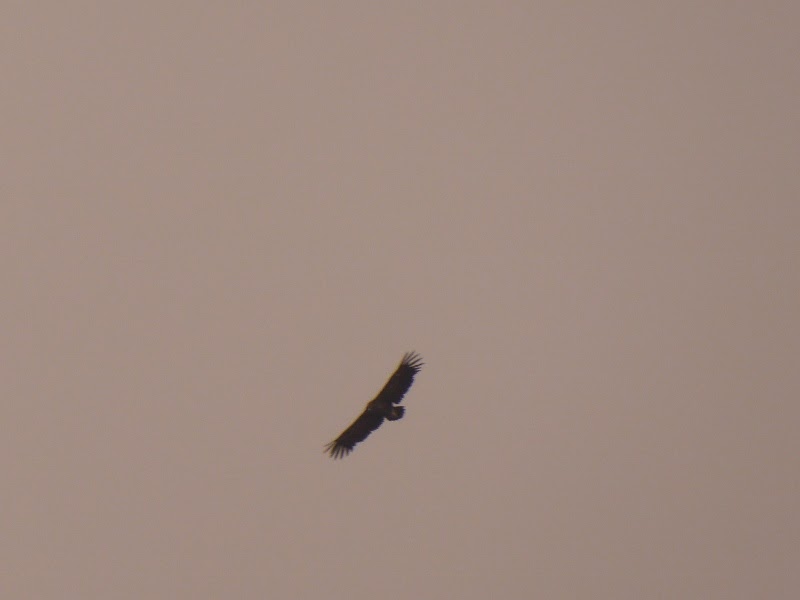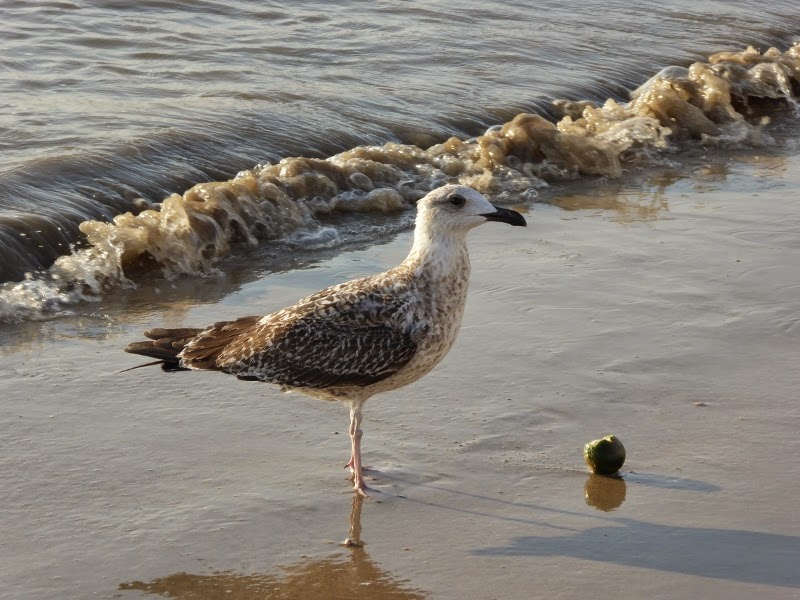After my trip to The Scillies the weather improved and it was warm and sunny. I managed to get out for a walk at Wembury on the 18th and the 21st September where the best sightings were a whinchat, 4 ringed plovers and 3 bar-tailed godwits along with clouded yellows and long winged coneheads. The weather was also good on a walk along the coastpath from Hope Cove to Thurlestone on the 20th September and the best sightings were 4 little stints feeding together with dunlin at South Huish Marsh, giving some nice views despite all the cars and people nearby.
Sand Wasp on Sea Holly at Thurlestone
Green Carpet at Wembury
Whinchat at Wembury
Whinchat
Whinchat
Female Long Winged Conehead, Wembury
Common Darter, Wembury
And on September 22nd we headed off on the train to Heathrow Airport for our flight to Madrid in Spain for Davids sumptuous 52nd birthday holiday extravaganza. The journey was delayed due to a jumper in front of a train and it was a bit tight but we caught our flight which was actually late taking off anyway. On the journey up to Heathrow I managed to see a kingfisher and the resident Slavonian grebe along the River Exe, a few distant views of red kites around the Reading area and a flock of around 20 common cranes in a field near Taunton, presumably part of the Great Crane Project release programme.
And so to Spain. Madrid was as lovely as ever although the weather this time was a lot more varied with rain, cloud and wind as well as hot and sunny days. Birding in Madrid was limited but pied flycatchers and monk parakeets were very noticeable in the parks, being noisy and relatively confiding at times.
Monk Parakeet, Madrid
Pied Flycatcher, Madrid
A day trip to nearby Segovia on the 24th was very interesting despite my tooth ache which at times was totally distracting. The Roman aqueduct was very impressive and I saw some good birds too with the biggest surprise being 2 choughs flying around the Alczar. Other highlights were red kites, black redstarts and cattle egrets and at least it distracted me from my painful tooth. I also had good views of 4 vultures, 1 was an adult griffon vulture and the other 3 were all black and I ignorantly assumed they were juvenile griffon vultures. Later when checking my bird book I realised they were actually 3 rare black vultures and a life tick for me.
Roman Aqueduct at Segovia
The Alcazar at Segovia
Male Black Redstart, Segovia
Chough, The Alcazar at Segovia
Chough, Segovia
Griffon Vulture, Segovia
Black Vulture, Segovia
Heading down to Cadiz by train on the 26th and I managed frustrating views of birds of prey - eagles, buzzards, vultures, falcons, kites and harriers - with a probable short toed eagle and a probable black shouldered kite being seen as we whizzed across the countryside at 150+mph. Nearing Cadiz the train travelled slower and I saw a nice hovering osprey over some salt flats along with black winged stilts and greater flamingos.
Cadiz was lovely too and it was nice to actually stay in the old city for a few days to explore after our first 3 hour day trip in 2011. Monk parakeets were again noticeable due to being so noisy and confiding. The rocky shore had roosting whimbrel, ringed plover, sanderling and turnstone at high tide while offshore Sandwich terns and gannets were seen - it was great to sit on the breakfast terrace of the hotel and watch juvenile gannets dive for fish (mostly unsuccessfully) quite close in to shore. Best of all though were the gulls - black headed, Mediterranean, lesser black backed and yellow legged - which provided me with hours of distraction and enjoyment. The yellow legged gulls were ridicously tame at times, much as herring gulls can be in Plymouth, and I was able to fully appreciate a range of different ages and plumages. I have seen adults and juvenile yellow legged gulls before but have never paid much attention to non-adult birds, a shame as I have spent the summer looking for juveniles here in Devon and Cornwall! I was surprised at how variable the juvenile birds were in size as well as plumage and while sitting on the decking around the hotel swimming pool I was kept absorbed by the birds coming down to drink and bathe in the pool just a few meters away.

Geranium Bronze, Cadiz
Speckled Wood?, Cadiz
Cadiz Beach
2nd Cal.Yr. Yellow Legged Gull
Juv. YLG
Juv. YLG
Juv. YLG
2nd Cal. Yr. YLG
Juv. YLG with pale eye
Adult LBBG
Adult YLG - With red orbital ring
Juv. YLG
Moving on to Seville on the 29th and birding slowed again but I did manage to see ring necked parakeets along with monk parakeets, spotted flycatcher and blackcap. A day trip to Cordoba on Davids birthday on the 30th provided a bit more variety with kingfisher, Cettis warbler and common sandpiper along the river and a few red rumped swallows overhead.
Long tailed Blue, Cordoba
Lizard sp., Cordoba
The Alcazar Gardens in Cordoba - stunning
The Mesquita, Cordoba
Alcazar Gardens, Seville
The Alcazar, Seville
Bee sp., Seville
The train journey from Seville to Madrid on the 3rd October was very nice as we travelled in first class, enjoying food and drinks in a comfortable carriage as we sped along. I managed to see 3 hoopoes flying off as we sped past along with more frustrating views of raptors and a hare cowering by the trackside underneath a road bridge. Our last day in Madrid was quiet but we did see some small bats flying over the water at the Temple of Debod when it as lit up at night and the next morning it was time to head off to the airport and the flight back to the UK.
The Temple Of Debod by night, Madrid
The Temple of Debod
Heading back to Plymouth by train and I managed some better views of red kites including one bird which flew low over the train carriage as we came to a halt at Reading station and I again saw the Slavonian grebe on the River Exe but there was no sign of any common cranes this time.
And so it had been a great holiday despite my tooth problems. I didn't do any real birding but managed to see around 60 species with quality not quantity being the order of the day. And it was great to see so many yellow legged gulls and so well, a great help for me to try and finally find one here in the UK.











































.jpg)






